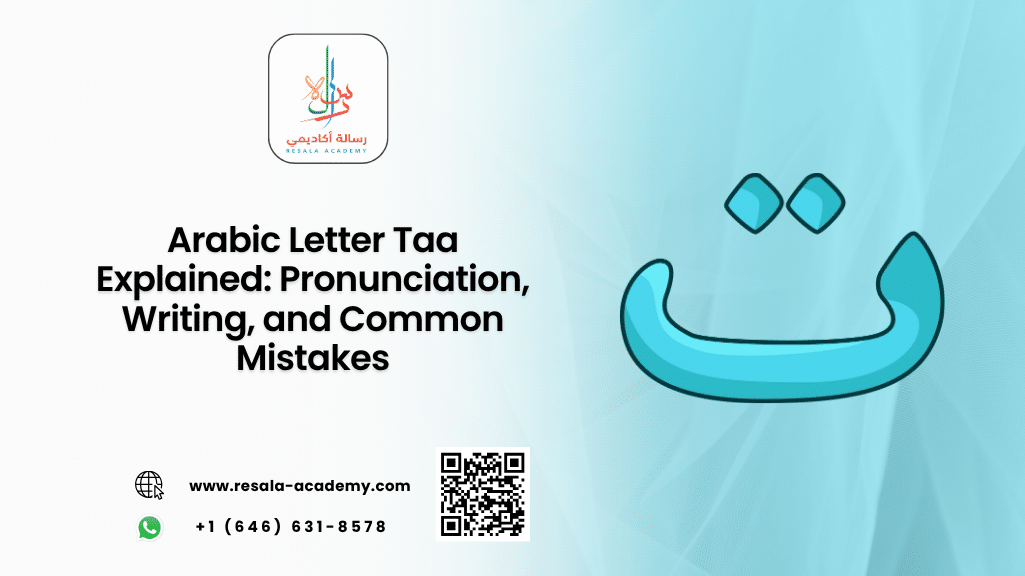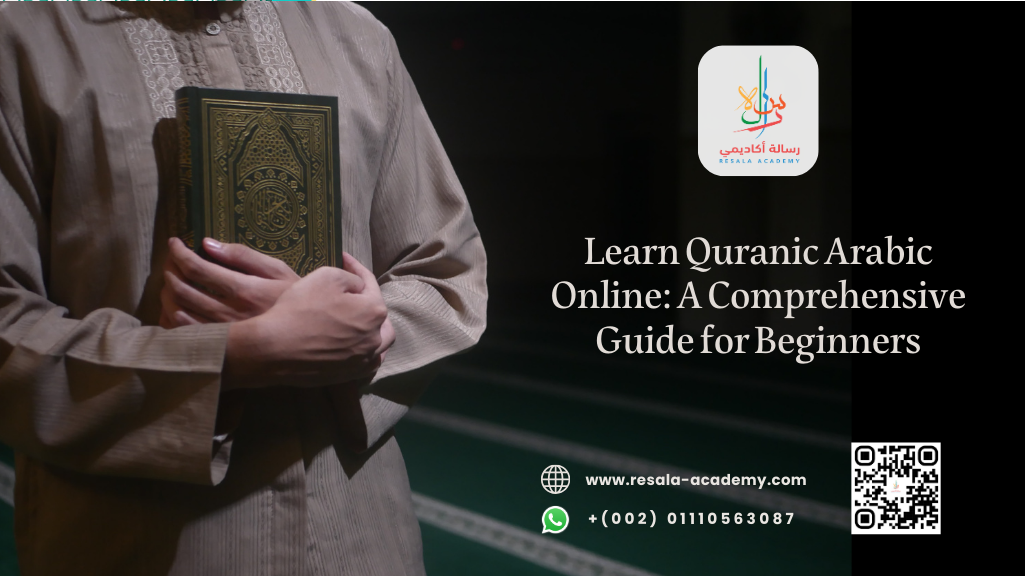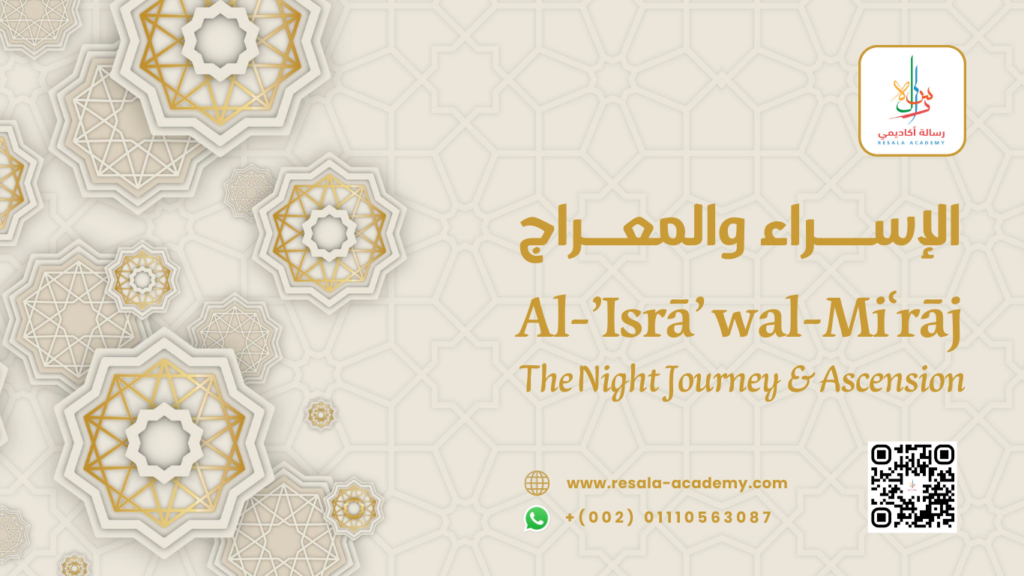Table of Contents
Arabic Letter Taa Explained: Pronunciation, Writing, and Common Mistakes
Learning the Arabic alphabet is the first step toward mastering the Arabic language. Among the 28 letters, the Arabic letter Taa (ت) is one of the most commonly used and essential characters. Whether you’re learning Arabic for religious, academic, or personal reasons, understanding the nuances of this letter is vital.
In this comprehensive guide, we’ll explore the pronunciation, writing techniques, and common mistakes associated with the Arabic letter Taa. We’ll also introduce you to Resala Academy, a leading online platform for Arabic and Quran education tailored specifically for non-native speakers.
What is the Arabic Letter Taa (ت)?
The Arabic letter Taa (ت) is the third letter in the Arabic alphabet. It corresponds to the “T” sound in English, as in the word “table.” It is a voiceless alveolar plosive, produced by placing the tip of the tongue against the upper front teeth.
Key Features of Taa:
- Name in Arabic: تاء (Taa)
- Phonetic Sound: /t/
- Position in Alphabet: 3rd
- Transliteration: “t”
- Type: Sun letter (affects pronunciation in definite articles)
How to Pronounce Taa Correctly
To pronounce the Arabic letter Taa, follow these steps:
- Place your tongue against the upper front teeth.
- Push air through without vibrating your vocal cords.
- Release quickly to produce a crisp “t” sound.
This sound is similar to the English “t” in “top” or “take,” but it is softer and more controlled in Arabic.
Audio Resources for Pronunciation
Listening to native speakers is essential for mastering pronunciation. Many resources offer audio-visual materials and live sessions with native Arabic tutors to help you perfect your pronunciation.
Writing the Arabic Letter Taa
Arabic is written from right to left, and each letter can take on different forms depending on its position in a word.
Forms of Taa
| Position | Form | Example | English Translation |
|---|---|---|---|
| Isolated | ت | تين | Figs |
| Initial | تـ | تلميذ | Student |
| Medial | ـتـ | فتاة | Girl |
| Final | ـت | بيت | House |
Writing Tips
- Use a smooth, curved motion when writing Taa.
- Ensure the two dots above the letter are clear and evenly spaced.
- Practice writing Taa in all positions to build muscle memory.
Click here for a detailed guide on writing Arabic letters.
Common Mistakes with Taa
Learning a new script always comes with challenges. Here are some frequent errors learners make with the Arabic letter Taa:
1. Confusing Taa (ت) with Other Letters
- Taa (ت) vs. Baa (ب): Baa has one dot below, Taa has two dots above.
- Taa (ت) vs. Thaa (ث): Thaa has three dots above.
2. Incorrect Dot Placement
Misplacing or omitting the two dots can change the letter entirely, leading to miscommunication.
3. Pronunciation Errors
Some learners pronounce Taa too harshly, making it sound like the emphatic letter Taa’ (ط), which has a deeper, more forceful sound.
4. Inconsistent Letter Connection
Arabic is a cursive script. Failing to connect Taa properly with adjacent letters can make your writing unreadable.
Read more about: Seen Arabic Letter: A Deep Dive into the Letter س in Arabic Language
Taa in Arabic Vocabulary
The Arabic letter Taa appears in many commonly used words. Here are a few examples:
- تلميذ (tilmīdh) — Student
- تفاح (tuffāḥ) — Apple
- تاريخ (tārīkh) — History
- تسعة (tisʿa) — Nine
- توحيد (tawḥīd) — Monotheism
These words are frequently used in daily conversation and Quranic Arabic, making Taa a crucial letter to master.
Taa in Quranic Arabic
The Arabic letter Taa is prevalent in the Quran, appearing in many verses and chapters. For instance:
وَالتِّينِ وَالزَّيْتُونِ
“By the fig and the olive”
(Surah At-Tin, 95:1)
The word التين (At-Tīn) starts with the letter Taa. Understanding such words is vital for Quranic comprehension, and Resala Academy offers specialized online Quran classes for non-native speakers to help with this.
How Resala Academy Helps You Master Arabic
Resala Academy is a premier online institution dedicated to teaching Arabic and Quran to non-native speakers. Their comprehensive curriculum, expert tutors, and interactive tools make it easier than ever to learn the Arabic script, including the letter Taa.
Why Choose Resala Academy?
✅ Native Arabic-speaking instructors
✅ Flexible class schedules
✅ One-on-one and group sessions
✅ Tailored lessons for all proficiency levels
✅ Quran memorization and Tajweed courses
Whether you’re a beginner or looking to refine your skills, Resala Academy provides a structured and supportive learning environment.
Advanced Linguistic Insights into the Arabic Letter Taa
Morphological Role in Root Structures:
The Arabic letter Taa (ت) frequently appears as a root or derivative letter in triliteral verb forms, especially in Form V and VI verbs (e.g., تعلّم – “to learn”, تبادل – “to exchange”). Understanding how Taa functions within these patterns enhances your grasp of Arabic morphology and verb conjugation, which is essential for academic and Quranic Arabic comprehension.
Grammatical Significance in Feminine Nouns:
Taa is also used in its special form Taa Marbouta (ة) to denote feminine gender in nouns and adjectives. For instance, مدرسة (madrasa – “school”) ends with a Taa Marbouta, indicating its feminine nature. Recognizing this grammatical marker is crucial for sentence agreement and accurate translation, especially for learners aiming to read classical texts or engage in formal Arabic writing.
Cognitive Techniques for Memorizing the Arabic Letter Taa
Visual Mnemonics and Shape Association:
Learners can associate the shape of Taa (ت) with a “smiling face” with two eyes (dots) on top. This visual cue helps differentiate it from similar letters like Baa (ب) and Thaa (ث), which vary only in the number and position of dots. Such mnemonic devices significantly boost character retention and recall speed.
Spaced Repetition with Contextual Vocabulary:
Incorporating the Arabic letter Taa into spaced repetition systems (SRS) using high-frequency words like تاريخ (history) or تفكير (thinking) allows learners to internalize both the letter and its usage in real-world contexts. Tools like Anki or Resala Academy’s interactive flashcards help reinforce this learning method effectively.
Unlock Your Arabic Potential with Resala Academy
Are you ready to take your Arabic learning to the next level?
Join thousands of students around the world who are mastering Arabic with Resala Academy. From learning the basics like the Arabic letter Taa to reading the Quran fluently, Resala Academy is your trusted partner on this linguistic journey.
Start your free trial today and experience the difference of expert-led, interactive Arabic education.
Frequently Asked Questions (FAQ)
1. What is the difference between Taa (ت) and Taa’ (ط)?
Taa (ت) is a soft “t” sound, similar to the English “t.”
Taa’ (ط) is an emphatic, deeper “t” sound made with a constricted throat.
2. How can I practice writing the letter Taa?
Practice by:
- Tracing worksheets
- Writing words with Taa in different positions
- Using online tools like Lexilogos Arabic Keyboard
Resala Academy provides downloadable writing exercises and live feedback from tutors.
3. Is Taa a sun letter or a moon letter?
Taa is a sun letter, which means it causes the definite article “ال” (al-) to assimilate.
Example: التفاح (at-tuffāḥ) — The apple.
4. How often does Taa appear in the Quran?
Taa appears frequently in the Quran, especially in verbs and nouns. Words like توحيد (monotheism) and توبة (repentance) are rooted in Quranic Arabic.
Explore Quranic vocabulary with Resala Academy.
5. Can children learn the Arabic letter Taa easily?
Yes! With visual aids, repetition, and interactive lessons, children can learn Taa quickly. Resala Academy offers special Arabic classes for kids with fun and engaging content.
Conclusion
The Arabic letter Taa (ت) is more than just a character — it’s a foundational building block of the Arabic language. From pronunciation and writing to avoiding common mistakes, understanding Taa is essential for anyone serious about learning Arabic.
With the expert guidance of Resala Academy, non-native speakers can confidently master the Arabic alphabet and progress to reading, writing, and understanding Arabic fluently. Whether you’re learning for religious, academic, or personal reasons, Resala Academy is your gateway to success.
Ready to begin your Arabic journey? Join Resala Academy today and take the first step toward fluency.




